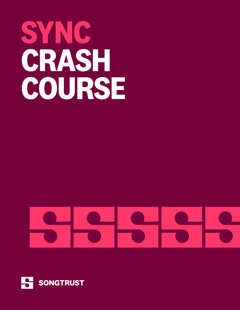If you’ve ever wondered “is sync licensing worth it?”, the answer may have been in the RIAA’s annual report for 2022. While streaming revenue saw its first stretch of single digit growth since the financial crisis — 7% year-over-year — sync royalties skyrocketed nearly 25% in the same time period for a total of $382.5 million. Not bad considering revenue from music sync licensing had last peaked at $285.5 million in 2018, and slid for several years before a 14.2% rebound in 2021.
“[Sync royalties are] the fastest-growing revenue category now,” explains Bill Rosenblatt, a technology consultant and adjunct music business professor at NYU. How fast, exactly? In his Forbes story, Rosenblatt says that sync licenses “should overtake both CD and download revenue by [2024],” with “the potential to keep growing at a healthy pace for a while.”
Billboard first reported on the music industry’s sudden resurgence of sync revenue in September of 2022, calling the 29.9% increase in the RIAA’s mid-year report “an uncharacteristically large gain…more than any other sector on a percentage basis.”
Reservoir Media is one publisher that witnessed this wave firsthand. According to its CEO, Golnar Khosrowshahi, the company’s music sync licensing revenue grew a staggering 70% in the second quarter of 2022. Much of that had to do with the simple fact that consumers are watching more original content than ever before. And since the cultural landscape is so competitive, many of those programs and movies use compelling music to grab the wavering attention of viewers.
Wondering how to sync license your music and land the perfect deal? Here are some key questions to keep in mind….
What Rights and Parties Are Involved?
Whenever a song is used alongside moving images on a screen — regardless of whether it’s a movie, television show, or video game — a sync license is required from both the recording and composition owner. These licenses are often obtained in exchange for a flat, upfront fee.
In addition to yourself and any other writers or rightsholders on the song(s), a publisher, your label (if you’re with one), and possibly your distributor will be involved, as well as the music supervisor or sync house that you’re negotiating with. It all depends on who and how you’ve set up your team – if you’re just starting out, it’s possible that you are the sole party working with the music supervisor offering the deal.
What Is a Typical Sync Fee?
Let’s be real: not everyone’s work is going to garner a car or iPhone commercial. Many artists simply land a three-figure license in a cable show or — if they’re lucky — a thousand-dollar sync on a major network like NBC.
When it comes to weighing various sync offers, “[i]t is important to keep asking questions about the scale of the opportunity, and how the music will be used,” attorney Steven Masur writes in Synchank. “As that picture becomes more and more clear, you will be able to ascertain how real the opportunity is and attain a comfortable idea of the appropriate fee for your work.”
In his experience, this fee is typically flat, ranging “from a few hundred dollars for a small artist in a small project to a few hundred thousand dollars for a major artist whose song is being used in a large budget production.”
One rare example of a major sync license is the Super Bowl. Variety called 2021 a “booming year” for sync placements thanks to the myriad deals that were landed in the leadup to Super Bowl LV, including 11 syncs by Sony/ATV, seven by Universal Music Publishing, five by Warner/Chappell, and three by BMG and Kobalt. Almost all of these licenses were linked to superstar artists, however, including Lenny Kravitz (“It Ain’t Over Til It’s Over” for Stella Artois), Lil Nas X (“Call Me By Your Name” for Logitech), and Dolly Parton (“9 to 5” for Squarespace). Shaggy’s “It Wasn’t Me” single was also reworked for a Cheetos commercial starring Ashton Kutcher and Mila Kunis, because why not, right?
What Kind of Publishing Royalties Do You Earn?
Songwriters earn public performance royalties in addition to any upfront fee whenever an audiovisual work is aired or streamed. For example, if your song is used in a commercial, you could receive a flat payment of $5000 and earn additional royalties each time the commercial is played or viewed. It’s important that you clarify this as you negotiate your deal – make sure you walk away fully understanding where and how your song will earn money.
When Should You Consider Sync?
Just as putting your music out on Spotify doesn’t automatically guarantee that your song will earn consistent royalty revenue, it also doesn’t guarantee that you’ll be pitched for sync or that you’re ready for a sync deal. There are a few things you need to do and consider before jumping into the proverbial sync waters – all of which we outline in this article. Just like you wouldn’t want to rush into a test without studying, make sure to do your homework and learn as much about the sync world as possible so that you understand how to advocate for yourself and your songs.
Who Handles Sync Deals?
Who handles the sync agreement can vary depending on the deal. As an independent artist or someone working with a publishing administrator that doesn’t offer creative services, you may find yourself negotiating the deal or pitching your songs for sync opportunities. If you’re signed to a label, they may assist with the process for a fee or as part of their regular services. On the other hand, traditional publishers often provide creative services, including sync pitching, but this typically comes at the cost of partial or full ownership of your copyrights.
At Songtrust, we do not take exclusive sync rights or pitch songs for sync placements. We believe in giving our clients the freedom to explore and secure sync opportunities that best align with their goals. While we don’t actively pursue sync deals, our experienced team can assist in negotiating a sync deal on your behalf, helping you secure the best possible terms. If we handle the negotiation or paperwork for a sync deal, we charge our standard 15% fee on any revenue collected, whether it’s the up-front fee or residual publishing royalties.
To learn more, check out 10 of Songtrust’s top licensing articles in our Help Center, or if you’d like a deeper understanding of music sync licensing, be sure to sign up for our free, on-demand Sync Crash Course.






